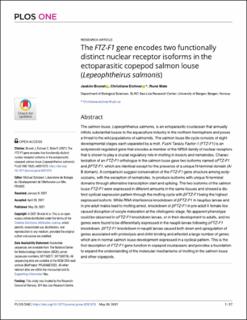| dc.contributor.author | Brunet, Joakim | |
| dc.contributor.author | Eichner, Christiane | |
| dc.contributor.author | Male, Rune | |
| dc.date.accessioned | 2022-04-06T07:55:04Z | |
| dc.date.available | 2022-04-06T07:55:04Z | |
| dc.date.created | 2021-08-19T12:59:50Z | |
| dc.date.issued | 2021 | |
| dc.identifier.issn | 1932-6203 | |
| dc.identifier.uri | https://hdl.handle.net/11250/2990069 | |
| dc.description.abstract | The salmon louse, Lepeophtheirus salmonis, is an ectoparasitic crustacean that annually inflicts substantial losses to the aquaculture industry in the northern hemisphere and poses a threat to the wild populations of salmonids. The salmon louse life cycle consists of eight developmental stages each separated by a molt. Fushi Tarazu Factor-1 (FTZ-F1) is an ecdysteroid-regulated gene that encodes a member of the NR5A family of nuclear receptors that is shown to play a crucial regulatory role in molting in insects and nematodes. Characterization of an FTZ-F1 orthologue in the salmon louse gave two isoforms named αFTZ-F1 and βFTZ-F1, which are identical except for the presence of a unique N-terminal domain (A/B domain). A comparison suggest conservation of the FTZ-F1 gene structure among ecdysozoans, with the exception of nematodes, to produce isoforms with unique N-terminal domains through alternative transcription start and splicing. The two isoforms of the salmon louse FTZ-F1 were expressed in different amounts in the same tissues and showed a distinct cyclical expression pattern through the molting cycle with βFTZ-F1 being the highest expressed isoform. While RNA interference knockdown of βFTZ-F1 in nauplius larvae and in pre-adult males lead to molting arrest, knockdown of βFTZ-F1 in pre-adult II female lice caused disruption of oocyte maturation at the vitellogenic stage. No apparent phenotype could be observed in αFTZ-F1 knockdown larvae, or in their development to adults, and no genes were found to be differentially expressed in the nauplii larvae following αFTZ-F1 knockdown. βFTZ-F1 knockdown in nauplii larvae caused both down and upregulation of genes associated with proteolysis and chitin binding and affected a large number of genes which are in normal salmon louse development expressed in a cyclical pattern. This is the first description of FTZ-F1 gene function in copepod crustaceans and provides a foundation to expand the understanding of the molecular mechanisms of molting in the salmon louse and other copepods. | en_US |
| dc.language.iso | eng | en_US |
| dc.publisher | PLOS | en_US |
| dc.rights | Navngivelse 4.0 Internasjonal | * |
| dc.rights.uri | http://creativecommons.org/licenses/by/4.0/deed.no | * |
| dc.title | The FTZ-F1 gene encodes two functionally distinct nuclear receptor isoforms in the ectoparasitic copepod salmon louse (Lepeophtheirus salmonis) | en_US |
| dc.type | Journal article | en_US |
| dc.type | Peer reviewed | en_US |
| dc.description.version | publishedVersion | en_US |
| dc.rights.holder | Copyright 2021 The Author(s) | en_US |
| dc.source.articlenumber | e0251575 | en_US |
| cristin.ispublished | true | |
| cristin.fulltext | original | |
| cristin.qualitycode | 1 | |
| dc.identifier.doi | 10.1371/journal.pone.0251575 | |
| dc.identifier.cristin | 1927294 | |
| dc.source.journal | PLOS ONE | en_US |
| dc.identifier.citation | PLOS ONE. 2021, 16 (5), e0251575. | en_US |
| dc.source.volume | 16 | en_US |
| dc.source.issue | 5 | en_US |

